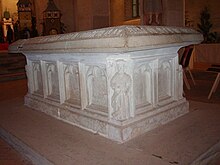Judith Welf

Judith Welf (* around 1100 ; † February 22, 1130 or 1131 ), also called Judith of Bavaria , was Duchess of Swabia.
She was the daughter of the Guelph Heinrich the Black . Around 1119/1120 she married the Staufer Duke Friedrich II of Swabia. In 1122 their first son was born, who later became Emperor Friedrich I Barbarossa .
Around 1123/24 a daughter named Berta was born, who later married Duke Matthew I of Lorraine. There is no precise information about the other children.
Her father Henry the Black played a special role in the 1125 election . At first he seemed to have promoted the candidacy of his son-in-law Friedrich II of Swabia. In the course of the discussions about the suitable candidate, however, he changed his mind and finally stood up for Duke Lothar von Sachsen, who thereby became Lothar III. was elected Roman-German king.
Judith Welf was buried in the Staufer graveyard donated by her father-in-law Duke Friedrich I in the Lorch monastery . There Abbot Nikolas Schenk von Arberg had all the Staufer graves opened in the central nave, in front of the steps of the choir and in the choir and the remains were collected in a tumba in the central nave of the monastery church. Her heart may have been buried in the Benedictine Abbey in Walbourg , where her husband and his second wife Agnes are also lying. These tombs can no longer be seen in the Sankt Walburga church.
Remarks
- ↑ a b c Hansmartin Decker-Hauff : The Staufer House. In: Württembergisches Landesmuseum (Hrsg.): The time of the Staufer. History - art - culture. Stuttgart 1977, Volume III, p. 349 and P. 352
- ^ Knut Görich : Friedrich Barbarossa. A biography. Munich 2011, p. 52
- ↑ a b c Peter Koblank: Staufer graves. Only a few of the most prominent Hohenstaufen are buried in Germany. on stauferstelen.net. Retrieved September 10, 2014.
- ↑ So z. B. Karl Rudolf Schnith: Medieval rulers in life pictures. From the Carolingians to the Hohenstaufen. Graz 1990, p. 263
| personal data | |
|---|---|
| SURNAME | Judith Welf |
| ALTERNATIVE NAMES | Judith of Bavaria |
| BRIEF DESCRIPTION | Duchess of Swabia |
| DATE OF BIRTH | around 1100 |
| DATE OF DEATH | February 22, 1130 or 1131 |
